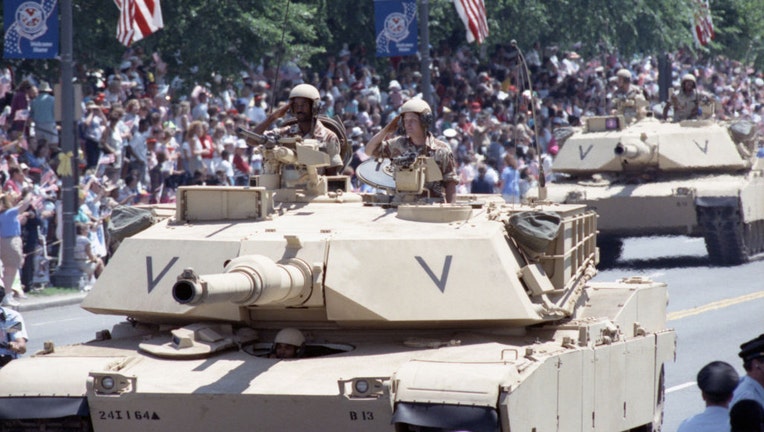Trump's military parade is a US outlier in peacetime but parades have storied history

FILE-M1A1 Abraham tanks parade down Constitution avenue in a victory parade in Washington, D.C. to honor troops that served in the Gulf War. (Photo by Getty Images/Bettmann)
President Donald Trump’s military parade honoring the U.S. Army’s 250th anniversary is expected to be a major event for many Americans this weekend in Washington, D.C.
Trump’s parade has the nation divided, with some supporting it and others feeling that it’s a waste of taxpayer dollars. The Associated Press reported that he has wanted to preside over a grand military parade since his first presidency from 2017 to 2021.
While this isn’t the first military parade in U.S. history, Trump’s unprecedented approach to holding the event outside of wartime stands out compared to previous presidents.
Past troop reviews
The backstory:
Ceremonial reviews, which refer to troops dressed up and conducting drills for top commanders, date back from medieval kingdoms to the ancient empires of Rome, Persia, and China.
In the U.S., presidents held military reviews during Fourth of July independence celebrations. But this ended with James K. Polk, who was president from 1845 to 1849, the Associated Press reported.
RELATED: Most Americans say Trump's military parade is not a good use of money, poll finds
President Andrew Johnson brought back the tradition in 1865, holding a two-day "Grand Review of the Armies" five weeks after Abraham Lincoln’s assassination. It came after Johnson said the Civil War was over, a sign of force meant to save a war-weary country.
The parade featured infantry, cavalry, and artillery units, 145,000 soldiers, and even cattle, traveling down Pennsylvania Avenue. Johnson, his Cabinet and top Army officers, including Ulysses S. Grant, Lincoln’s last commanding general and the future 18th president, watched from a White House viewing stand.
Spanish-American War and World War I started era of victory parades
Dig deeper:
According to the Associated Press, the Spanish-American War was the first major international conflict for a reunited nation since the Civil War. It ended in a U.S. victory that established an American empire.
New York City held several celebrations. In August 1898, a fleet of warships, including the Brooklyn, the Texas, and the Oregon, sailed up the North River, known today as the Hudson River.
RELATED: No Kings protests will rally against Trump Saturday: What to know
American inventor Thomas Edison filmed the parade. The following year, New York hosted a naval and street parade to welcome home Rear Adm. George Dewey, who joined President William McKinley in a viewing stand.
According to the Associated Press, some U.S. cities held World War I victory parades a few decades later. But neither Washington nor President Woodrow Wilson was the focal point. In Boston, a million civilians celebrated 20,000 troops in 1919. New York honored 25,000 troops marching in full uniform and combat gear.
New York City parade for World War II
Local perspective:
On June 13, 1942, roughly 30,000 people formed a parade in New York City as U.S. involvement in World War II intensified.
Army and Navy members, American Women’s Voluntary Services members, Boy Scouts, and military school cadets were among the participants in the event. There were also, including one with a large bust of President Franklin Roosevelt.
According to the Associated Press, the 82nd Airborne Division and Sherman tanks led a victory parade in New York City less than four years later. Gen. Dwight Eisenhower rode in a victory parade in Washington, D.C. In 1952, Eisenhower joined Ulysses S. Grant and George Washington as top wartime commanders promoted to the presidency after their military accomplishments. Other World War II generals were honored in other homecoming parades.
Military parades not held for years amid several wars
Big picture view:
Years later, the U.S. did not hold national or major city parades after wars in Korea and Vietnam. Both ended without clear victory. According to the Associated Press, the Vietnam War spurred societal divisions, to the point that President Gerald Ford was opposed to a strong military presence in 1976 bicentennial celebrations, held a year after the fall of Saigon.
In 1991, Washington, D.C. hosted a victory parade after the first Persian Gulf War. The event lineup featured 8,000 troops, tanks, Patriot missiles and representatives of the international coalition, led by the U.S., that quickly drove an invading Iraq out of Kuwait.
President George H.W. Bush was the last commander-in-chief to hold an active-duty military post. Bush was a World War II combat pilot who survived his plane being shot down over the Pacific Ocean.
The AP noted that veterans of the second Iraq and Afghanistan wars that followed the Sept. 11, 2001, attacks have not been honored in national parades.
The Source: Information for this story was provided by the Associated Press, which gives historical background on military parades. This story was reported from Washington, D.C.

